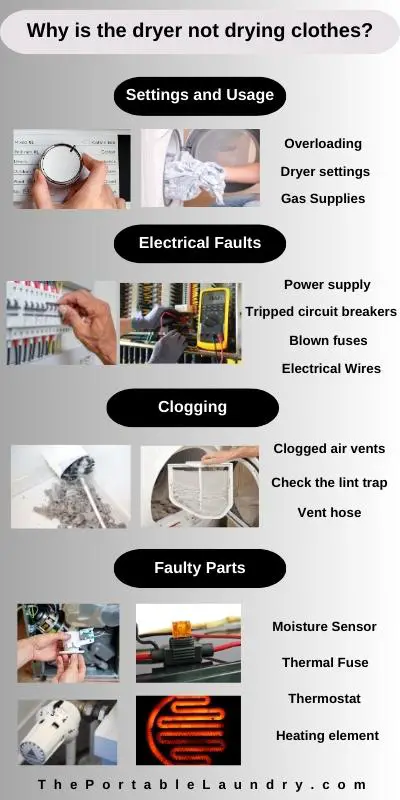There may be several reasons why the dryer is not drying clothes. Some of the common reasons include clogged air vents, overloading, incorrect dryer settings, non-functional moisture sensors, problematic heating elements, and damaged thermal fuses or thermostats.
Let’s quickly go over some common reasons why the dryer might not function as it should in detail.

Overloading
An overloaded dryer will always struggle to dry clothes.
This is because a dryer that is too full will have trouble moving the air around, which will make it hard to get moisture out of the clothes.
So, the first thing you need to do is see if your dryer was too full after the cycle is completed.
If the clothes are still damp, try taking some of them out and running the cycle again.
There should always be some space left in the dryer for air to circulate. Therefore, do not load the dryer to its maximum capacity.
As a best practice, spread the clothes evenly around the drum.
This will allow hot air to circulate better and help the clothes dry faster.
Clogged air vents
Another possible reason why the dryer is not drying clothes could be because the air vents are clogged.
The air vent is what allows hot air to circulate and exit the dryer, so if it’s blocked, the dryer will struggle to get rid of the moisture in the clothes.
A good way to check if the air vent is clogged is to feel the exhaust pipe after the dryer has been running for a while.
If the pipe is hot, then that means the air is flowing freely.
If the pipe is not hot, then that means the air is not flowing freely and the vent might be clogged.
Dryer settings
If the dryer settings are incorrect, the dryer will also struggle to dry clothes.
For example, if the heat setting is too low, it will take longer to dry the clothes.
Therefore, always make sure that the heat setting is on high when you are trying
Similar to washing machines, there are a few settings on your dryer that could be the culprit if your clothes are not coming out completely dry.
Check to see if your dryer is set to “air dry” or a similar setting, as this will not generate enough heat to fully dry your clothes.
You can check for heat settings if they were set properly. If not, switch the setting to “moderate or high heat” or a similar option. Make sure the garments inside the dryer’s drum are suitable for such temperature settings.
Power supply
If your clothes dryer did not dry your clothes, check if the power supply is stable and make sure the dryer is properly plugged in.
If the power cord is loose, it may cause an interruption in the power supply, which may cause voltage stability issues.
So, if this is the case, re-start the dry cycle and check if the clothes are dry after the cycle completes.
Gas (Supply and Knob or valve)
Now, this is applicable to gas dryers that use natural or propane gas to generate heat.
One possibility is that the gas supply to the dryer is not working properly or there is no gas supply at all.
You can check these aspects and then proceed toward the knob or the gas valve.
Check if the gas knobs are set to function as desired.
Additionally, you can check if the gas valve was turned on.
If the gas supply is not working, then the dryer will not be able to generate heat and dry the clothes.
Moisture Sensor
If your dryer isn’t drying clothes, one possible reason is that the moisture sensor is dirty.
The moisture sensor is usually located on the inside of the dryer drum, and it helps to regulate the amount of time your dryer runs.
If the sensor is messy, it can cause the dryer to run for too long, which can lead to performance issues.
To clean the moisture sensor, you’ll need to remove the dryer drum and then wipe down the sensor with a damp cloth.
Check the lint trap
The lint trap or lint filter captures lint and debris from your clothes as they dry, and due to prolonged usage, they may get clogged.
So, there is always a possibility of clogging in the lint trap. Therefore, it needs cleaning.
If you leave it untreated, it can cause your dryer to work less efficiently.
To clean your lint trap, simply remove it from the dryer and clean it with a brush or vacuum.
You should do this every few weeks to ensure that your dryer is working properly.
Vent hose
If your dryer isn’t drying clothes, the first thing you should check is the dryer vent hose.
If the hose is clogged or damaged, it could be preventing air from flowing through the vent and into the dryer.
To inspect the hose, take it off the dryer and vacuum out any lint that has built up inside.
If the hose is cracked or torn, replace it with a new one.
Once you’ve checked (and cleaned or replaced) the vent hose, run a load of laundry to see if that solves the problem.
Thermal Fuse
A blown thermal fuse can be another reason that your dryer isn’t drying clothes the usual way.
A thermal fuse is a safety device and is meant to blow if the temperature exceeds the set level inside the dryer.
It not only prevents your clothes from being damaged but also prevents fires due to excess heat generated by the heating element.
Usually, this thermal fuse is located right next to your dryer’s heating element.
The most confusing thing about a blown thermal fuse is that the dryer may still work, but the heating element may not perform as it should.
As a result, no heat will be produced within the drum, and the clothing will come out in a damp state.
You will need to replace a blown thermal fuse in order to restore your dryer’s functionality.
Here’s a quick step-by-step guide to replacing the thermal fuse.
Thermostat
A thermostat is another important device in a dryer that monitors the temperature inside the dryer.
It is like a switch that turns off the power to the heating element if the temperature rises above the set level.
Likewise, it will resume the power supply when the temperature drops.
A faulty thermostat can not only block the power supply to the heating element but also send false signals.
It is easy to replace a thermostat and you can replace it by following our detailed guide on replacing the thermostat here.
Note: You can always test the thermostat using a multimeter to make sure it is actually faulty before deciding to replace it.
Heating element
Now, comes the actual source equipped inside the dryer that does all the work of heating, i.e., the heating element.
If your dryer is not drying clothes, it could be due to a faulty heating element that might need to be replaced.
The heating element is what provides the heat that dries the clothes.
If it’s not working properly, clothes may not get dry or they may take a long time to dry.
You can inspect the heating element first to see if it’s faulty or not, and then you may proceed accordingly.
To test whether the heating element is working, use a multimeter to check for continuity.
If there is continuity, the heating element is working fine; if there isn’t, then it is faulty and needs to be replaced.
You can easily replace a faulty heating element by following our detailed guide on replacing the heating element here.
Blown fuses or tripped circuit breakers
You can also check if there is a blown fuse or tripped circuit breaker.
To check for a blown fuse, look for a break in the metal strip inside the fuse.
If there is a break, the fuse needs to be replaced.
To check for a tripped circuit breaker, open the panel and look for a switch that is in the middle position or has been turned off.
Electrical Wires
A fault in the electrical wires can also be the cause of the dryer not heating up.
It may be possible that one or more electrical wires running through the heating element or related components may have worn out.
To identify such a cause, you will need to hire a service professional or contact the manufacturer for more information.
Final Thoughts
There is no single cause for a problematic dryer.
It can be one or a combination of the above-mentioned problems, or something else entirely.
That is why it is always recommended to diagnose the problem first based on the symptoms.
If you are uncomfortable or not confident enough to self-troubleshoot or diagnose, it’s best to seek professional help.
You May Also Like
- How to replace the drive belt in a dryer?
- How To Replace a Dryer Blower Wheel?
- 11 Creative Ideas to Recycle Washer and Dryer Drums
- Can you use a Dryer Drum for a Fire pit?
- How to replace the Igniter in a Gas Dryer?
- 14 Reasons Why Your Dryer is Squeaking & Solutions
- What is a Smart Washer and Dryer? (Explained)
- Washer Dryer: 27 Questions Answered
- Why do Korean Homes come with Washers but not Dryers?
- Gas Dryers vs Electric Dryers (Differences Explained)
- Damaged Dryer Vents: 8 signs your dryer vent is damaged
- Dryers & Vents: 20 frequently asked questions

